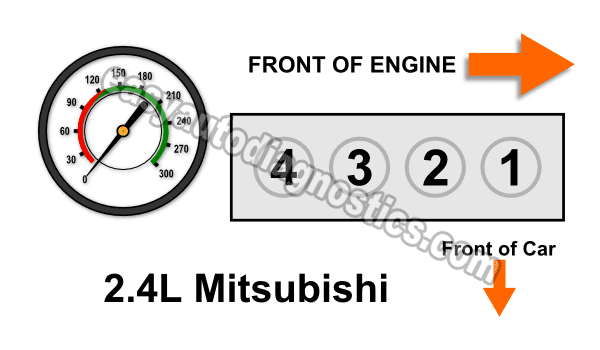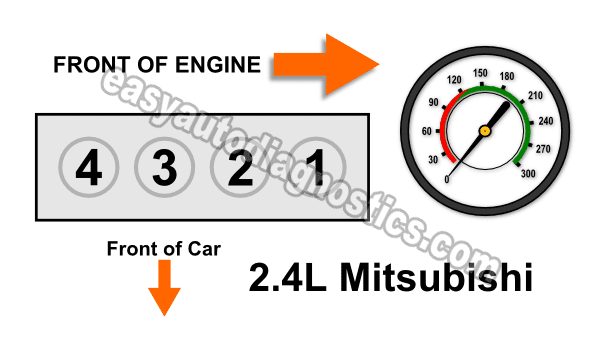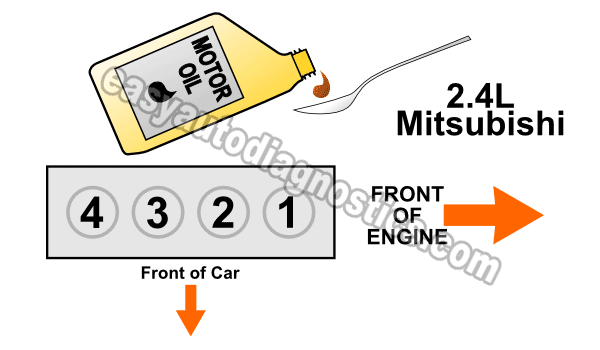
Doing a compression test on your 1.8L or 2.4L Mitsubishi (Chrysler, Dodge) vehicle is a pretty easy test to do and in this article, I'll show you how to get it done.
More importantly, I'm also gonna' show you how to interpret the results of the test.
Why do an engine compression test? Well, it may help you to find out if the engine is shot and if this is the reason why it won't start or the reason you have a hard to diagnose misfire condition.
Contents of this tutorial:
![]() You can find this tutorial in Spanish here: Cómo Probar La Compresión Del Motor (2.4L Mitsubishi) (at: autotecnico-online.com).
You can find this tutorial in Spanish here: Cómo Probar La Compresión Del Motor (2.4L Mitsubishi) (at: autotecnico-online.com).
Important Tips And Suggestions
TIP 1: If your vehicle starts and runs then I suggest that you perform the compression test with a slightly warmed up engine. My recommendation is to let a completely cold engine run for about 15 minutes and no more.
TIP 2: If your vehicle DOES NOT start and run then you don't have to worry about testing the compression of the cylinders with a warmed up engine.
TIP 3: The compression test is done with the engine cranking. So you need to take all necessary safety precautions. Be careful, use common sense and think safety all of the time.
TIP 4: You'll need to remove the spark plugs to perform the compression test. You should never remove spark plugs from a hot engine. Removing spark plugs from a hot engine can and will damage the spark plug threads in the cylinder head. This is a nightmare you do not want to experience.
Which Compression Tester Should I Buy?
There are lot of engine compression testers to choose from and many places to buy them. I'm gonna' make some recommendations to you:
Disclosure: As an Amazon Associate, I earn from qualifying purchases. Buying through these links helps support this site at no extra cost to you. Thanks for your support —it really means a lot!
TEST 1: Dry Compression Test

The illustration above will help you to make sense of the results of the engine compression test, since you need to know the number of the engine cylinder you're testing.
OK, this is what you'll need to do:
- 1
Disable the fuel system. You can easily do this by simply disconnecting the four fuel injectors from their electrical connectors.
Disabling the fuel system will prevent fuel from being injected into the engine cylinders when the engine is being cranked by your helper. - 2
Disable the ignition system.
If your vehicle has the Coil-On-Plug ignition system, you can skip this step and go to step 4 since you've already disabled the ignition system when you removed the ignition coils from the engine to get to the spark plugs.
If your vehicle has a distributor type ignition system, then you can disable the ignition system by disconnecting all of the distributor's electrical connectors. Do not move on to the next step without first doing this. - 3
Disconnect the spark plug wires from the spark plugs. Label the spark plug wires before you disconnect them from the spark plugs.
NOTE: This only applies to the vehicles with an ignition distributor. - 4
Remove the spark plugs.
When removing the spark plugs, be careful not to drop any of them on the floor, or you run the risk of having the spark plugs porcelain insulator crack and then you'll have a misfire on your hands. - 5
Thread the engine compression gauge into the spark plug hole for the number 1 engine cylinder.
Hand tighten the compression gauge only! Do not use any type of tool to get it tight. - 6
Have your helper crank the engine.
- 7
Once the needle on the compression gauge stops climbing, have your helper stop cranking the engine.
- 8
Now, record on paper the value at which the needle stopped and the number of the engine cylinder on a piece of paper.
Release the pressure on the gauge and repeat this step one more time. - 9
Repeat steps 5 and 8 on the remaining three cylinders.
Let's take a look at what your compression test results mean:
CASE 1: No compression in 2 or more cylinders. This test result tells you that the engine has serious internal problems.
The most common issues would be:
- Busted timing belt.
- A blown head gasket.
- The engine threw a rod.
To test for a blown head gasket, see this tutorial: How To Test For a Blown Head Gasket (Mitsubishi 1.8L, 2.4L).
CASE 2: Low compression in one or more cylinders. To a certain point, it's normal for the compression to vary a little between cylinders (as the engine accumulates thousands of miles). But if these values vary too much, then you're gonna' have a bonafide misfire on your hands.
So, your next step is to do the math and find out if these compression values are within normal parameter or not. Go to: Interpreting Your Compression Test Results.
Interpreting Your Compression Test Results
It's not unusual to see a low compression value among your compression test results.
Most of the time, a low compression value will not cause a problem. But if the value is too low, then you'll have a rough idle problem or a misfire problem on your hands.
What you have to do is find out if this low compression value varies by more than 15% of the highest compression value you obtained from your tests.
Why? Because if the low compression value varies by more than 15%, then this cylinder is going to misfire and can be considered 'dead'.
You can do this one of two ways: You can calculate this 15% difference with pen and paper or you can use my low compression calculator. You can find the low compression calculator here: Online Low Engine Compression Calculator.
If you want to manually calculate the 15% difference, here's what you'll need to do:
- STEP 1: Multiply the highest compression value by 0.15 (this is the decimal value of 15%).
- STEP 2: Round the result to the nearest one (for example: 25.6 would become 26).
- STEP 3: Subtract the result (the number that was rounded) from the highest compression value.
- ANSWER: The result of this subtraction is the lowest possible compression value any cylinder can have.
Now, let me give you a more specific example: Let's say that I got the following compression readings:
| Cylinder | Pressure |
|---|---|
| #1 | 165 PSI |
| #2 | 95 PSI |
| #3 | 155 PSI |
| #4 | 175 PSI |
My next step is to do the following calculation:
- STEP 1: 175 x 0.15 = 26.25.
- STEP 2: 26.25 = 26 (rounded to nearest one).
- STEP 3: 175 - 26 = 149.
- ANSWER: 149 PSI. Any cylinder with this compression (or lower) value will misfire.
Since cylinder #2 is only producing 95 PSI, I can now conclude that it's 'dead' and causing a misfire.
To find out if the lowest compression value you got from your engine compression test is within a good range, you'll need to do the same calculation. Of course, you'll need to use the highest compression value you got and not the one in the example.
Once you've found the 'dead' cylinder, the next step is to find out what's causing the low compression value. For this step, go to: TEST 2: Wet Compression Test.
TEST 2: Wet Compression Test

The very last step, if you have one or more cylinders that have very low compression values, is to do a wet compression test on those specific cylinders.
This type of test will help you find out if the low compression value is due to worn valves in the cylinder head or worn rings on the pistons.
This involves adding a spoonful of engine oil to the affected cylinder and testing the compression again.
OK, this is what you'll need to do:
- 1
Add a tablespoon of engine oil in the cylinder you need to retest.
I suggest using a small and long funnel so that the oil will reach the inside of the cylinder. - 2
Once you've added the oil, install the compression gauge and as before just hand tighten it.
- 3
Now, have your helper crank the engine till the needle stops climbing on the compression gauge.
- 4
You'll see one of two results:
1.) The needle will climb higher than the previous compression number you recorded for this specific cylinder.
2.) The needle will not move at all or stay at the same number you recorded earlier.
What ever value your compression tester reads, write it down again. - 5
Repeat steps 1 thru' 4 on any other cylinder with a low compression value.
Let's examine your test results:
CASE 1: The needle on the gauge registered a higher value. This tells you that the lack of compression (or low compression) recorded earlier is due to bad or severely worn piston rings.
CASE 2: The needle DID NOT move beyond the previous recorded value. This result tells you that the problem is due to worn intake or exhaust valves in the cylinder head.
Why An Engine Compression Test?
One of the things that can cause a misfire condition (also known as a miss or dead cylinder), is an engine cylinder or engine cylinders that produce less than normal compression.
When this happens, not matter what gets replaced (like spark plugs, spark plug wires, fuel injectors), nothing solves the miss. This is when the compression test comes in to save the day.
Over the years, I have solved many unsolvable misfire codes, rough idle, lack of power issues by doing a simple engine compression test and if you're faced with something similar then I highly recommend doing an engine compression test.
More Diagnostic Tutorials
To see all of the 1.8L and 2.4L Mitsubishi (Dodge, Chrysler) specific articles here at troubleshootmyvehicle. Com, go to: Mitsubishi 2.4L Index Of Articles.
Here's a sample of the articles, you'll find in the Index of Articles:
- Crank Sensor Test And Ignition Coil Tests.
- MAF Sensor Test.
- Throttle Position Sensor Test.
- How To Test The Alternator.
- How To Bench Test The Starter Motor.

If this info saved the day, buy me a beer!




